Stakeholder Analysis Report for MGT501 Business Environment
VerifiedAdded on 2023/03/20
|14
|3866
|20
Report
AI Summary
This report provides a detailed analysis of stakeholder roles and stakeholder management within the business environment, using Woolworths as a case study. It begins with an introduction to stakeholder analysis, defining internal and external stakeholders and their significance. The report then explores the functional areas of Woolworths and the roles of its stakeholders, including employees, customers, suppliers, and shareholders. It examines stakeholder management strategies employed by Woolworths and assesses the level of influence of various stakeholders. A stakeholder matrix is created to analyze the interests and power of different stakeholders. Finally, the report compares Woolworths to other industries and concludes with key findings and recommendations. The report utilizes frameworks and theories relevant to management organizations to provide a comprehensive understanding of the subject.
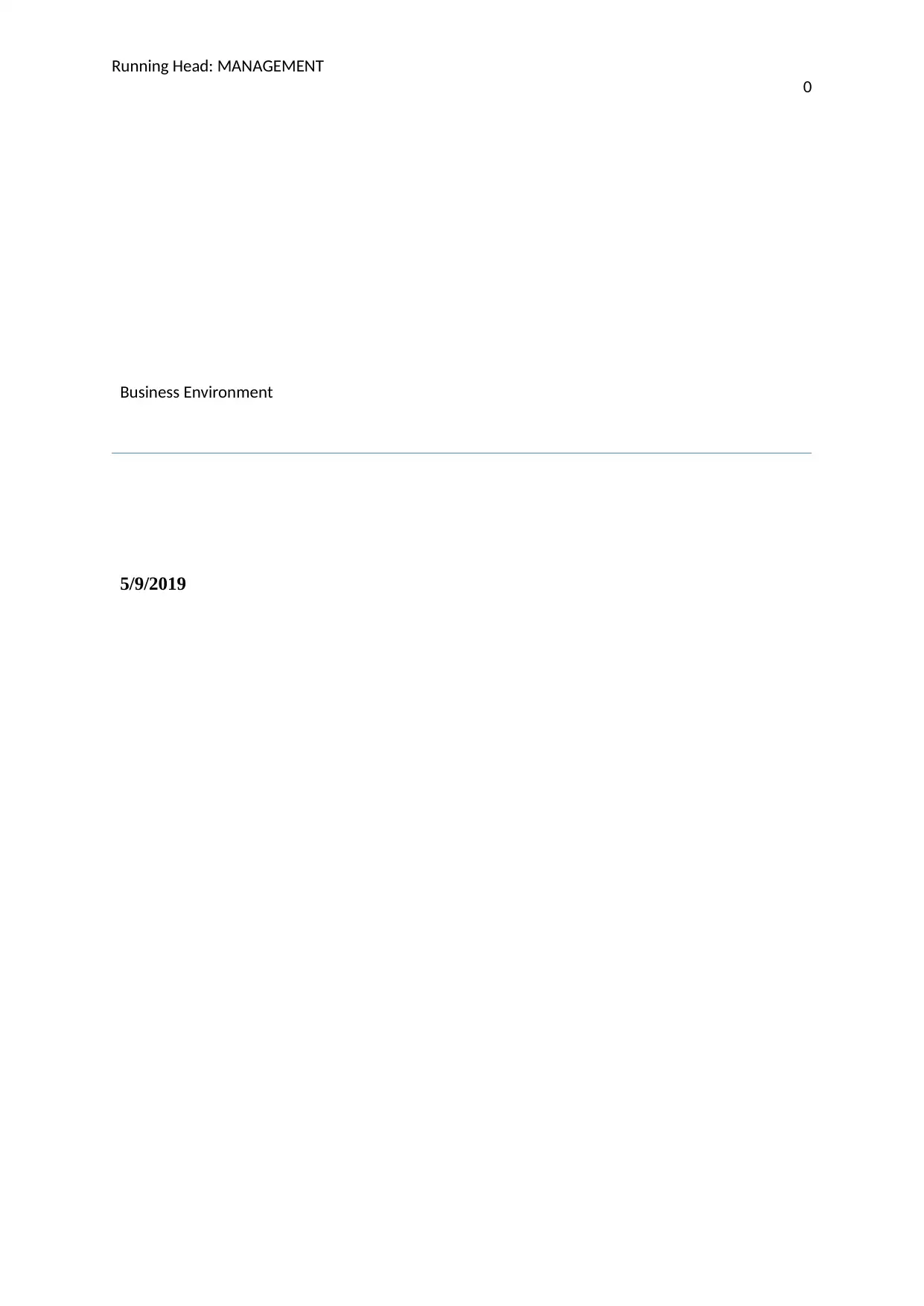
Running Head: MANAGEMENT
0
Business Environment
5/9/2019
0
Business Environment
5/9/2019
Paraphrase This Document
Need a fresh take? Get an instant paraphrase of this document with our AI Paraphraser
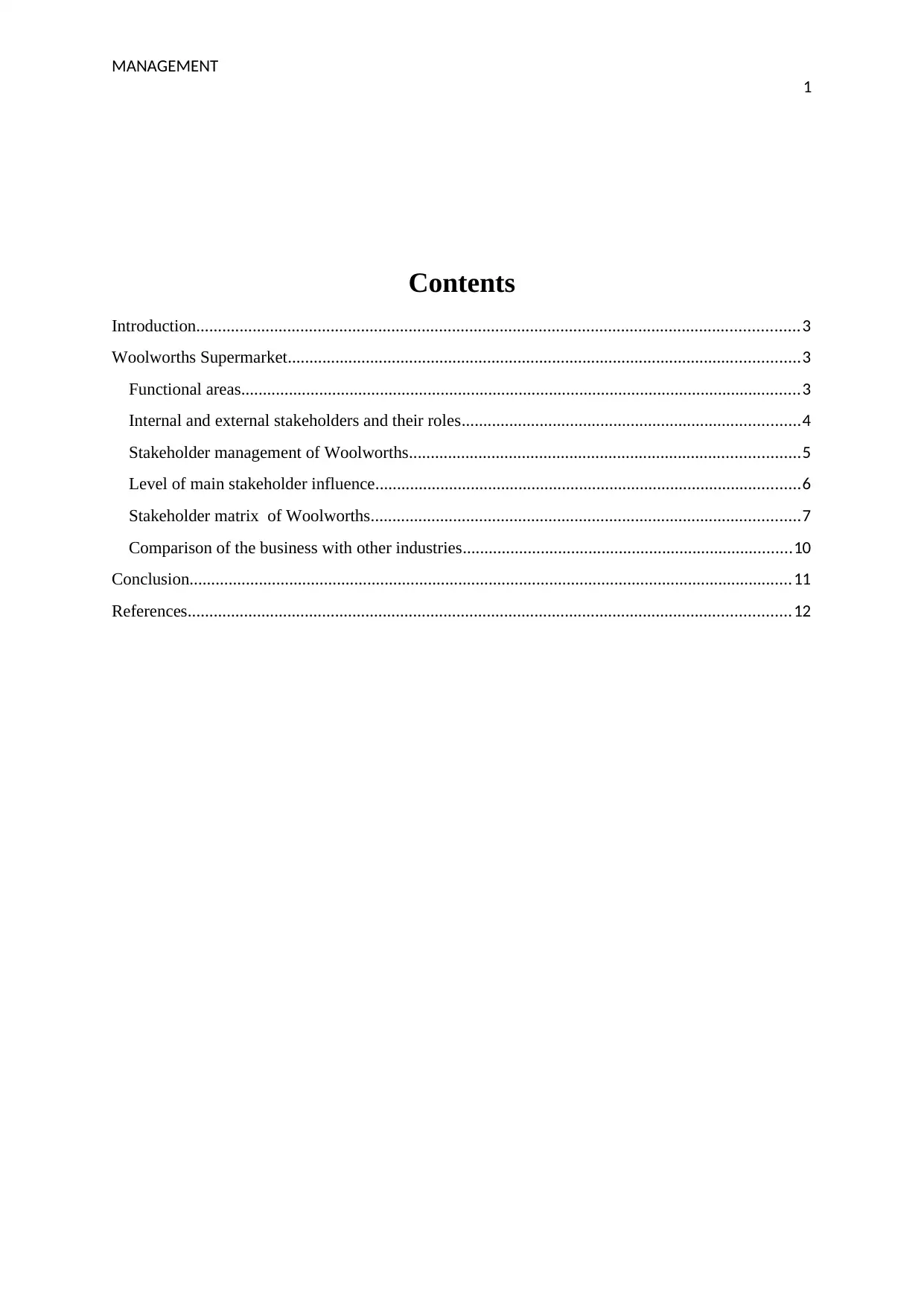
MANAGEMENT
1
Contents
Introduction...........................................................................................................................................3
Woolworths Supermarket......................................................................................................................3
Functional areas.................................................................................................................................3
Internal and external stakeholders and their roles..............................................................................4
Stakeholder management of Woolworths..........................................................................................5
Level of main stakeholder influence..................................................................................................6
Stakeholder matrix of Woolworths...................................................................................................7
Comparison of the business with other industries............................................................................10
Conclusion...........................................................................................................................................11
References...........................................................................................................................................12
1
Contents
Introduction...........................................................................................................................................3
Woolworths Supermarket......................................................................................................................3
Functional areas.................................................................................................................................3
Internal and external stakeholders and their roles..............................................................................4
Stakeholder management of Woolworths..........................................................................................5
Level of main stakeholder influence..................................................................................................6
Stakeholder matrix of Woolworths...................................................................................................7
Comparison of the business with other industries............................................................................10
Conclusion...........................................................................................................................................11
References...........................................................................................................................................12
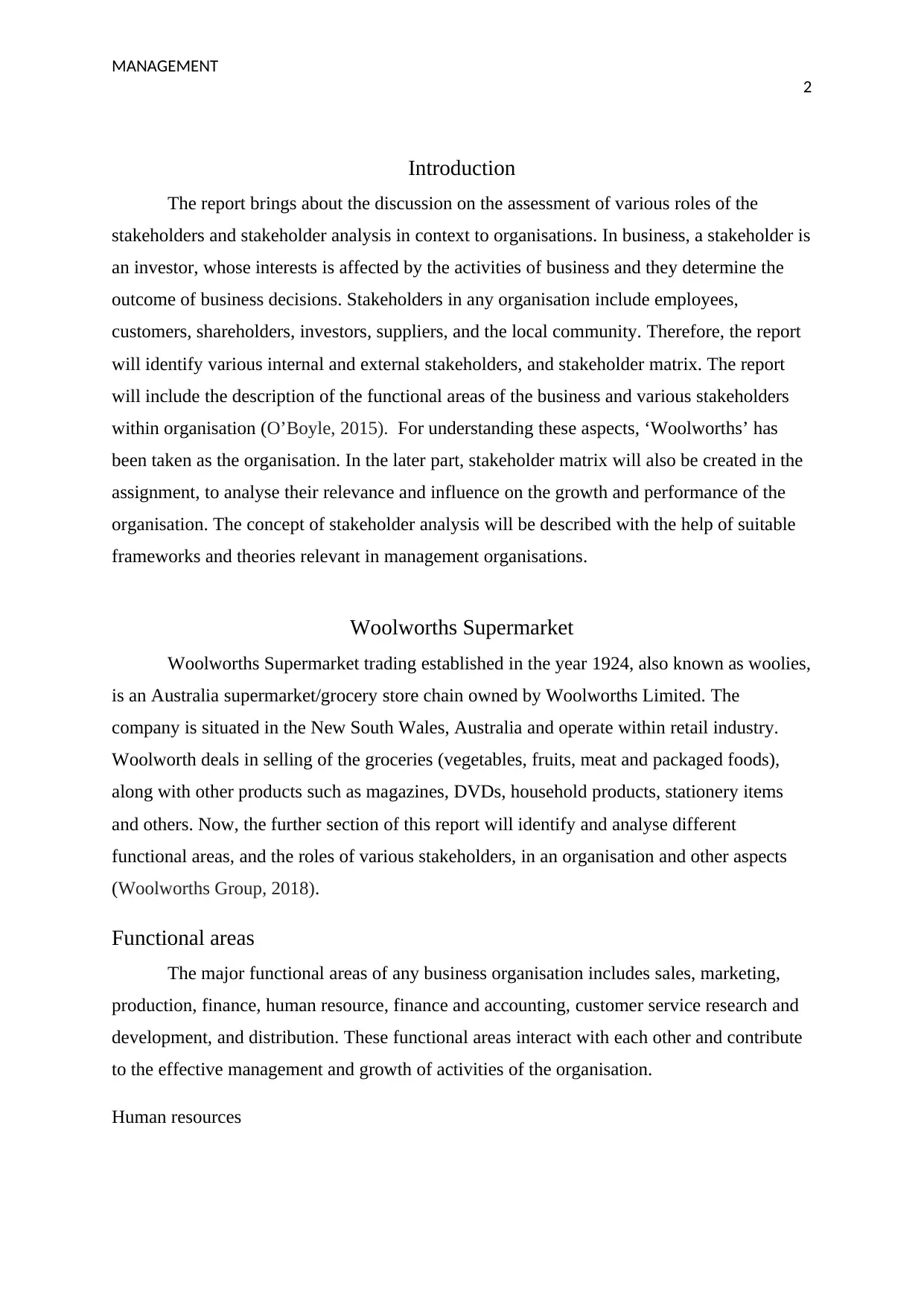
MANAGEMENT
2
Introduction
The report brings about the discussion on the assessment of various roles of the
stakeholders and stakeholder analysis in context to organisations. In business, a stakeholder is
an investor, whose interests is affected by the activities of business and they determine the
outcome of business decisions. Stakeholders in any organisation include employees,
customers, shareholders, investors, suppliers, and the local community. Therefore, the report
will identify various internal and external stakeholders, and stakeholder matrix. The report
will include the description of the functional areas of the business and various stakeholders
within organisation (O’Boyle, 2015). For understanding these aspects, ‘Woolworths’ has
been taken as the organisation. In the later part, stakeholder matrix will also be created in the
assignment, to analyse their relevance and influence on the growth and performance of the
organisation. The concept of stakeholder analysis will be described with the help of suitable
frameworks and theories relevant in management organisations.
Woolworths Supermarket
Woolworths Supermarket trading established in the year 1924, also known as woolies,
is an Australia supermarket/grocery store chain owned by Woolworths Limited. The
company is situated in the New South Wales, Australia and operate within retail industry.
Woolworth deals in selling of the groceries (vegetables, fruits, meat and packaged foods),
along with other products such as magazines, DVDs, household products, stationery items
and others. Now, the further section of this report will identify and analyse different
functional areas, and the roles of various stakeholders, in an organisation and other aspects
(Woolworths Group, 2018).
Functional areas
The major functional areas of any business organisation includes sales, marketing,
production, finance, human resource, finance and accounting, customer service research and
development, and distribution. These functional areas interact with each other and contribute
to the effective management and growth of activities of the organisation.
Human resources
2
Introduction
The report brings about the discussion on the assessment of various roles of the
stakeholders and stakeholder analysis in context to organisations. In business, a stakeholder is
an investor, whose interests is affected by the activities of business and they determine the
outcome of business decisions. Stakeholders in any organisation include employees,
customers, shareholders, investors, suppliers, and the local community. Therefore, the report
will identify various internal and external stakeholders, and stakeholder matrix. The report
will include the description of the functional areas of the business and various stakeholders
within organisation (O’Boyle, 2015). For understanding these aspects, ‘Woolworths’ has
been taken as the organisation. In the later part, stakeholder matrix will also be created in the
assignment, to analyse their relevance and influence on the growth and performance of the
organisation. The concept of stakeholder analysis will be described with the help of suitable
frameworks and theories relevant in management organisations.
Woolworths Supermarket
Woolworths Supermarket trading established in the year 1924, also known as woolies,
is an Australia supermarket/grocery store chain owned by Woolworths Limited. The
company is situated in the New South Wales, Australia and operate within retail industry.
Woolworth deals in selling of the groceries (vegetables, fruits, meat and packaged foods),
along with other products such as magazines, DVDs, household products, stationery items
and others. Now, the further section of this report will identify and analyse different
functional areas, and the roles of various stakeholders, in an organisation and other aspects
(Woolworths Group, 2018).
Functional areas
The major functional areas of any business organisation includes sales, marketing,
production, finance, human resource, finance and accounting, customer service research and
development, and distribution. These functional areas interact with each other and contribute
to the effective management and growth of activities of the organisation.
Human resources
⊘ This is a preview!⊘
Do you want full access?
Subscribe today to unlock all pages.

Trusted by 1+ million students worldwide
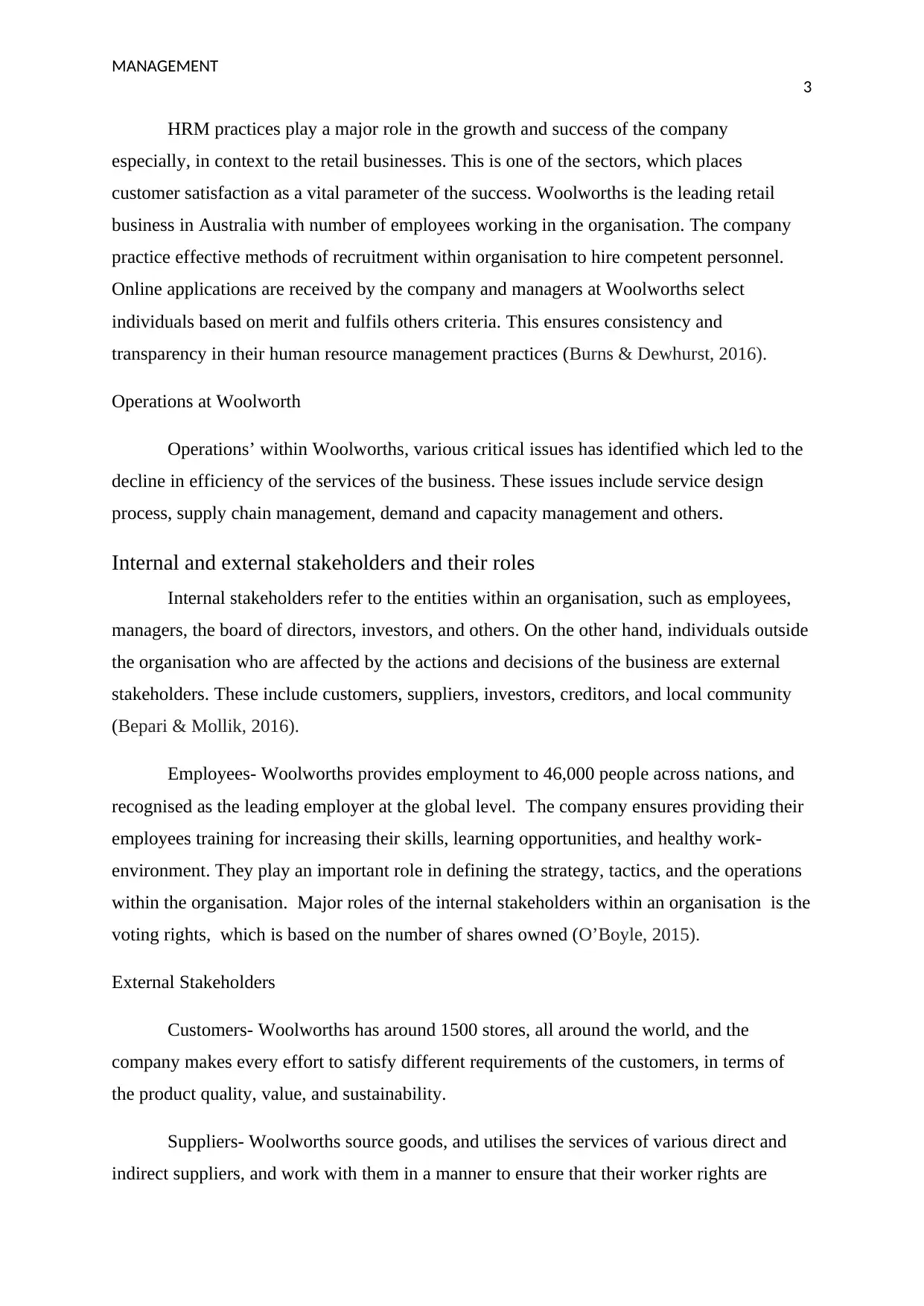
MANAGEMENT
3
HRM practices play a major role in the growth and success of the company
especially, in context to the retail businesses. This is one of the sectors, which places
customer satisfaction as a vital parameter of the success. Woolworths is the leading retail
business in Australia with number of employees working in the organisation. The company
practice effective methods of recruitment within organisation to hire competent personnel.
Online applications are received by the company and managers at Woolworths select
individuals based on merit and fulfils others criteria. This ensures consistency and
transparency in their human resource management practices (Burns & Dewhurst, 2016).
Operations at Woolworth
Operations’ within Woolworths, various critical issues has identified which led to the
decline in efficiency of the services of the business. These issues include service design
process, supply chain management, demand and capacity management and others.
Internal and external stakeholders and their roles
Internal stakeholders refer to the entities within an organisation, such as employees,
managers, the board of directors, investors, and others. On the other hand, individuals outside
the organisation who are affected by the actions and decisions of the business are external
stakeholders. These include customers, suppliers, investors, creditors, and local community
(Bepari & Mollik, 2016).
Employees- Woolworths provides employment to 46,000 people across nations, and
recognised as the leading employer at the global level. The company ensures providing their
employees training for increasing their skills, learning opportunities, and healthy work-
environment. They play an important role in defining the strategy, tactics, and the operations
within the organisation. Major roles of the internal stakeholders within an organisation is the
voting rights, which is based on the number of shares owned (O’Boyle, 2015).
External Stakeholders
Customers- Woolworths has around 1500 stores, all around the world, and the
company makes every effort to satisfy different requirements of the customers, in terms of
the product quality, value, and sustainability.
Suppliers- Woolworths source goods, and utilises the services of various direct and
indirect suppliers, and work with them in a manner to ensure that their worker rights are
3
HRM practices play a major role in the growth and success of the company
especially, in context to the retail businesses. This is one of the sectors, which places
customer satisfaction as a vital parameter of the success. Woolworths is the leading retail
business in Australia with number of employees working in the organisation. The company
practice effective methods of recruitment within organisation to hire competent personnel.
Online applications are received by the company and managers at Woolworths select
individuals based on merit and fulfils others criteria. This ensures consistency and
transparency in their human resource management practices (Burns & Dewhurst, 2016).
Operations at Woolworth
Operations’ within Woolworths, various critical issues has identified which led to the
decline in efficiency of the services of the business. These issues include service design
process, supply chain management, demand and capacity management and others.
Internal and external stakeholders and their roles
Internal stakeholders refer to the entities within an organisation, such as employees,
managers, the board of directors, investors, and others. On the other hand, individuals outside
the organisation who are affected by the actions and decisions of the business are external
stakeholders. These include customers, suppliers, investors, creditors, and local community
(Bepari & Mollik, 2016).
Employees- Woolworths provides employment to 46,000 people across nations, and
recognised as the leading employer at the global level. The company ensures providing their
employees training for increasing their skills, learning opportunities, and healthy work-
environment. They play an important role in defining the strategy, tactics, and the operations
within the organisation. Major roles of the internal stakeholders within an organisation is the
voting rights, which is based on the number of shares owned (O’Boyle, 2015).
External Stakeholders
Customers- Woolworths has around 1500 stores, all around the world, and the
company makes every effort to satisfy different requirements of the customers, in terms of
the product quality, value, and sustainability.
Suppliers- Woolworths source goods, and utilises the services of various direct and
indirect suppliers, and work with them in a manner to ensure that their worker rights are
Paraphrase This Document
Need a fresh take? Get an instant paraphrase of this document with our AI Paraphraser
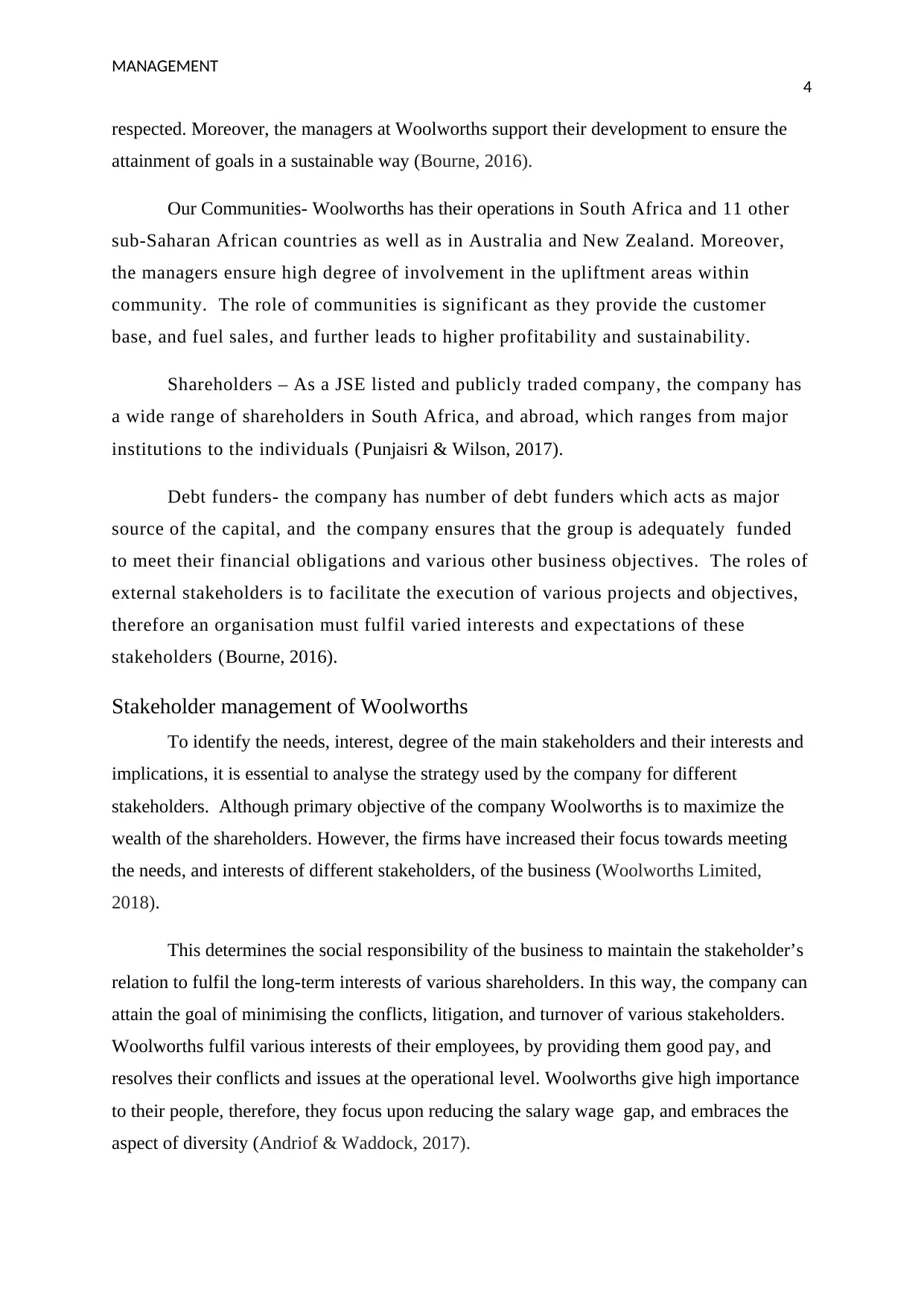
MANAGEMENT
4
respected. Moreover, the managers at Woolworths support their development to ensure the
attainment of goals in a sustainable way (Bourne, 2016).
Our Communities- Woolworths has their operations in South Africa and 11 other
sub-Saharan African countries as well as in Australia and New Zealand. Moreover,
the managers ensure high degree of involvement in the upliftment areas within
community. The role of communities is significant as they provide the customer
base, and fuel sales, and further leads to higher profitability and sustainability.
Shareholders – As a JSE listed and publicly traded company, the company has
a wide range of shareholders in South Africa, and abroad, which ranges from major
institutions to the individuals (Punjaisri & Wilson, 2017).
Debt funders- the company has number of debt funders which acts as major
source of the capital, and the company ensures that the group is adequately funded
to meet their financial obligations and various other business objectives. The roles of
external stakeholders is to facilitate the execution of various projects and objectives,
therefore an organisation must fulfil varied interests and expectations of these
stakeholders (Bourne, 2016).
Stakeholder management of Woolworths
To identify the needs, interest, degree of the main stakeholders and their interests and
implications, it is essential to analyse the strategy used by the company for different
stakeholders. Although primary objective of the company Woolworths is to maximize the
wealth of the shareholders. However, the firms have increased their focus towards meeting
the needs, and interests of different stakeholders, of the business (Woolworths Limited,
2018).
This determines the social responsibility of the business to maintain the stakeholder’s
relation to fulfil the long-term interests of various shareholders. In this way, the company can
attain the goal of minimising the conflicts, litigation, and turnover of various stakeholders.
Woolworths fulfil various interests of their employees, by providing them good pay, and
resolves their conflicts and issues at the operational level. Woolworths give high importance
to their people, therefore, they focus upon reducing the salary wage gap, and embraces the
aspect of diversity (Andriof & Waddock, 2017).
4
respected. Moreover, the managers at Woolworths support their development to ensure the
attainment of goals in a sustainable way (Bourne, 2016).
Our Communities- Woolworths has their operations in South Africa and 11 other
sub-Saharan African countries as well as in Australia and New Zealand. Moreover,
the managers ensure high degree of involvement in the upliftment areas within
community. The role of communities is significant as they provide the customer
base, and fuel sales, and further leads to higher profitability and sustainability.
Shareholders – As a JSE listed and publicly traded company, the company has
a wide range of shareholders in South Africa, and abroad, which ranges from major
institutions to the individuals (Punjaisri & Wilson, 2017).
Debt funders- the company has number of debt funders which acts as major
source of the capital, and the company ensures that the group is adequately funded
to meet their financial obligations and various other business objectives. The roles of
external stakeholders is to facilitate the execution of various projects and objectives,
therefore an organisation must fulfil varied interests and expectations of these
stakeholders (Bourne, 2016).
Stakeholder management of Woolworths
To identify the needs, interest, degree of the main stakeholders and their interests and
implications, it is essential to analyse the strategy used by the company for different
stakeholders. Although primary objective of the company Woolworths is to maximize the
wealth of the shareholders. However, the firms have increased their focus towards meeting
the needs, and interests of different stakeholders, of the business (Woolworths Limited,
2018).
This determines the social responsibility of the business to maintain the stakeholder’s
relation to fulfil the long-term interests of various shareholders. In this way, the company can
attain the goal of minimising the conflicts, litigation, and turnover of various stakeholders.
Woolworths fulfil various interests of their employees, by providing them good pay, and
resolves their conflicts and issues at the operational level. Woolworths give high importance
to their people, therefore, they focus upon reducing the salary wage gap, and embraces the
aspect of diversity (Andriof & Waddock, 2017).
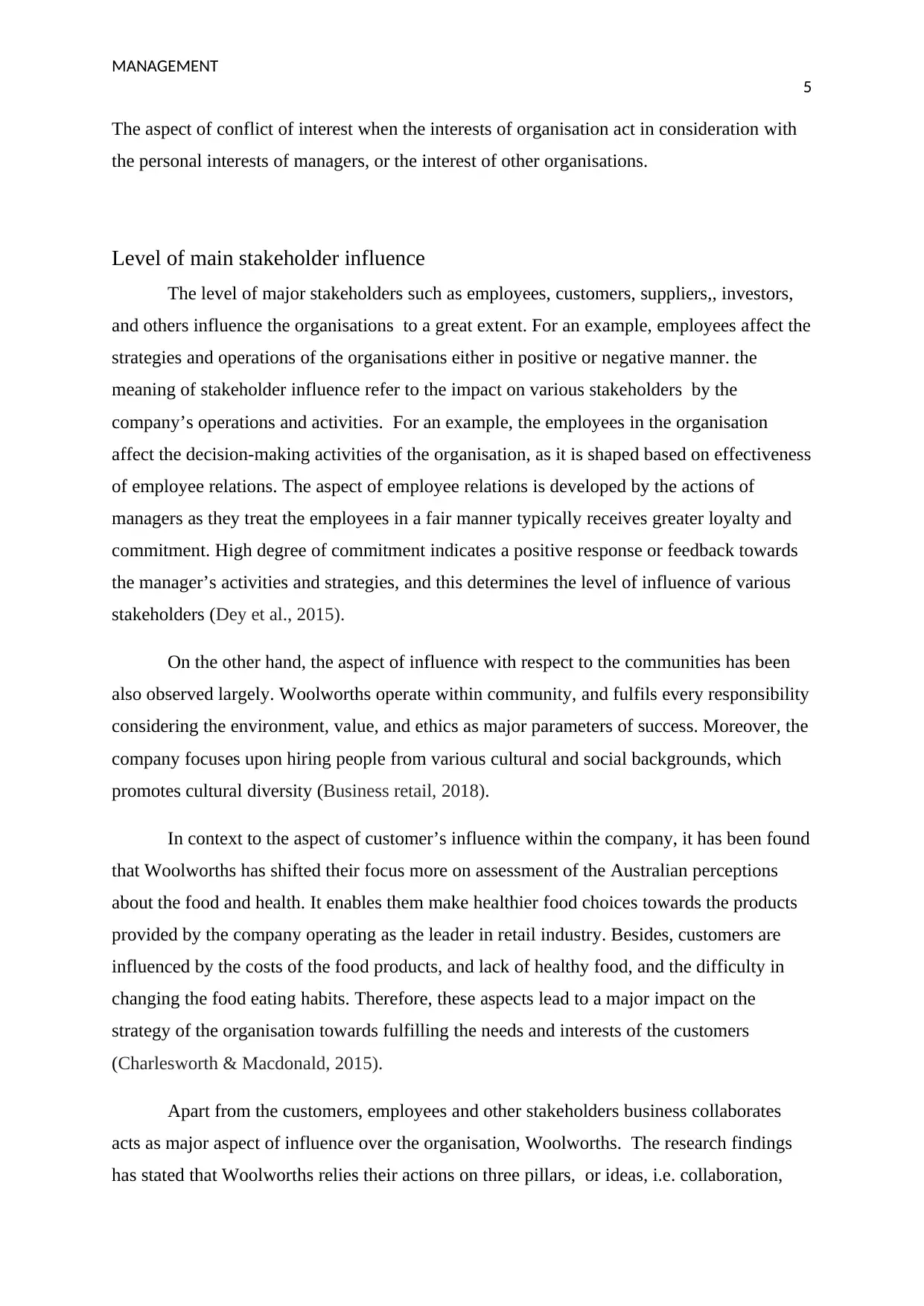
MANAGEMENT
5
The aspect of conflict of interest when the interests of organisation act in consideration with
the personal interests of managers, or the interest of other organisations.
Level of main stakeholder influence
The level of major stakeholders such as employees, customers, suppliers,, investors,
and others influence the organisations to a great extent. For an example, employees affect the
strategies and operations of the organisations either in positive or negative manner. the
meaning of stakeholder influence refer to the impact on various stakeholders by the
company’s operations and activities. For an example, the employees in the organisation
affect the decision-making activities of the organisation, as it is shaped based on effectiveness
of employee relations. The aspect of employee relations is developed by the actions of
managers as they treat the employees in a fair manner typically receives greater loyalty and
commitment. High degree of commitment indicates a positive response or feedback towards
the manager’s activities and strategies, and this determines the level of influence of various
stakeholders (Dey et al., 2015).
On the other hand, the aspect of influence with respect to the communities has been
also observed largely. Woolworths operate within community, and fulfils every responsibility
considering the environment, value, and ethics as major parameters of success. Moreover, the
company focuses upon hiring people from various cultural and social backgrounds, which
promotes cultural diversity (Business retail, 2018).
In context to the aspect of customer’s influence within the company, it has been found
that Woolworths has shifted their focus more on assessment of the Australian perceptions
about the food and health. It enables them make healthier food choices towards the products
provided by the company operating as the leader in retail industry. Besides, customers are
influenced by the costs of the food products, and lack of healthy food, and the difficulty in
changing the food eating habits. Therefore, these aspects lead to a major impact on the
strategy of the organisation towards fulfilling the needs and interests of the customers
(Charlesworth & Macdonald, 2015).
Apart from the customers, employees and other stakeholders business collaborates
acts as major aspect of influence over the organisation, Woolworths. The research findings
has stated that Woolworths relies their actions on three pillars, or ideas, i.e. collaboration,
5
The aspect of conflict of interest when the interests of organisation act in consideration with
the personal interests of managers, or the interest of other organisations.
Level of main stakeholder influence
The level of major stakeholders such as employees, customers, suppliers,, investors,
and others influence the organisations to a great extent. For an example, employees affect the
strategies and operations of the organisations either in positive or negative manner. the
meaning of stakeholder influence refer to the impact on various stakeholders by the
company’s operations and activities. For an example, the employees in the organisation
affect the decision-making activities of the organisation, as it is shaped based on effectiveness
of employee relations. The aspect of employee relations is developed by the actions of
managers as they treat the employees in a fair manner typically receives greater loyalty and
commitment. High degree of commitment indicates a positive response or feedback towards
the manager’s activities and strategies, and this determines the level of influence of various
stakeholders (Dey et al., 2015).
On the other hand, the aspect of influence with respect to the communities has been
also observed largely. Woolworths operate within community, and fulfils every responsibility
considering the environment, value, and ethics as major parameters of success. Moreover, the
company focuses upon hiring people from various cultural and social backgrounds, which
promotes cultural diversity (Business retail, 2018).
In context to the aspect of customer’s influence within the company, it has been found
that Woolworths has shifted their focus more on assessment of the Australian perceptions
about the food and health. It enables them make healthier food choices towards the products
provided by the company operating as the leader in retail industry. Besides, customers are
influenced by the costs of the food products, and lack of healthy food, and the difficulty in
changing the food eating habits. Therefore, these aspects lead to a major impact on the
strategy of the organisation towards fulfilling the needs and interests of the customers
(Charlesworth & Macdonald, 2015).
Apart from the customers, employees and other stakeholders business collaborates
acts as major aspect of influence over the organisation, Woolworths. The research findings
has stated that Woolworths relies their actions on three pillars, or ideas, i.e. collaboration,
⊘ This is a preview!⊘
Do you want full access?
Subscribe today to unlock all pages.

Trusted by 1+ million students worldwide
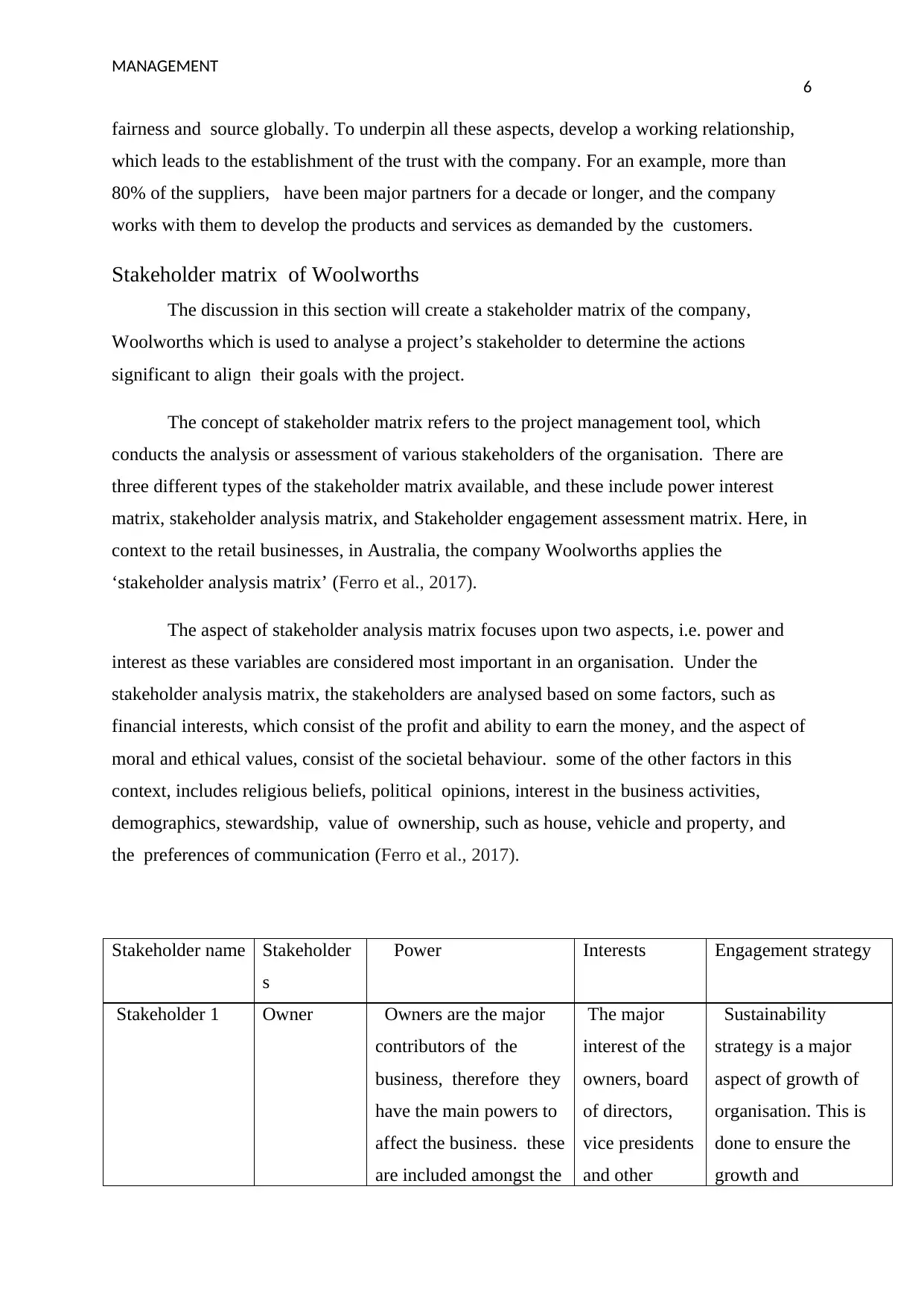
MANAGEMENT
6
fairness and source globally. To underpin all these aspects, develop a working relationship,
which leads to the establishment of the trust with the company. For an example, more than
80% of the suppliers, have been major partners for a decade or longer, and the company
works with them to develop the products and services as demanded by the customers.
Stakeholder matrix of Woolworths
The discussion in this section will create a stakeholder matrix of the company,
Woolworths which is used to analyse a project’s stakeholder to determine the actions
significant to align their goals with the project.
The concept of stakeholder matrix refers to the project management tool, which
conducts the analysis or assessment of various stakeholders of the organisation. There are
three different types of the stakeholder matrix available, and these include power interest
matrix, stakeholder analysis matrix, and Stakeholder engagement assessment matrix. Here, in
context to the retail businesses, in Australia, the company Woolworths applies the
‘stakeholder analysis matrix’ (Ferro et al., 2017).
The aspect of stakeholder analysis matrix focuses upon two aspects, i.e. power and
interest as these variables are considered most important in an organisation. Under the
stakeholder analysis matrix, the stakeholders are analysed based on some factors, such as
financial interests, which consist of the profit and ability to earn the money, and the aspect of
moral and ethical values, consist of the societal behaviour. some of the other factors in this
context, includes religious beliefs, political opinions, interest in the business activities,
demographics, stewardship, value of ownership, such as house, vehicle and property, and
the preferences of communication (Ferro et al., 2017).
Stakeholder name Stakeholder
s
Power Interests Engagement strategy
Stakeholder 1 Owner Owners are the major
contributors of the
business, therefore they
have the main powers to
affect the business. these
are included amongst the
The major
interest of the
owners, board
of directors,
vice presidents
and other
Sustainability
strategy is a major
aspect of growth of
organisation. This is
done to ensure the
growth and
6
fairness and source globally. To underpin all these aspects, develop a working relationship,
which leads to the establishment of the trust with the company. For an example, more than
80% of the suppliers, have been major partners for a decade or longer, and the company
works with them to develop the products and services as demanded by the customers.
Stakeholder matrix of Woolworths
The discussion in this section will create a stakeholder matrix of the company,
Woolworths which is used to analyse a project’s stakeholder to determine the actions
significant to align their goals with the project.
The concept of stakeholder matrix refers to the project management tool, which
conducts the analysis or assessment of various stakeholders of the organisation. There are
three different types of the stakeholder matrix available, and these include power interest
matrix, stakeholder analysis matrix, and Stakeholder engagement assessment matrix. Here, in
context to the retail businesses, in Australia, the company Woolworths applies the
‘stakeholder analysis matrix’ (Ferro et al., 2017).
The aspect of stakeholder analysis matrix focuses upon two aspects, i.e. power and
interest as these variables are considered most important in an organisation. Under the
stakeholder analysis matrix, the stakeholders are analysed based on some factors, such as
financial interests, which consist of the profit and ability to earn the money, and the aspect of
moral and ethical values, consist of the societal behaviour. some of the other factors in this
context, includes religious beliefs, political opinions, interest in the business activities,
demographics, stewardship, value of ownership, such as house, vehicle and property, and
the preferences of communication (Ferro et al., 2017).
Stakeholder name Stakeholder
s
Power Interests Engagement strategy
Stakeholder 1 Owner Owners are the major
contributors of the
business, therefore they
have the main powers to
affect the business. these
are included amongst the
The major
interest of the
owners, board
of directors,
vice presidents
and other
Sustainability
strategy is a major
aspect of growth of
organisation. This is
done to ensure the
growth and
Paraphrase This Document
Need a fresh take? Get an instant paraphrase of this document with our AI Paraphraser
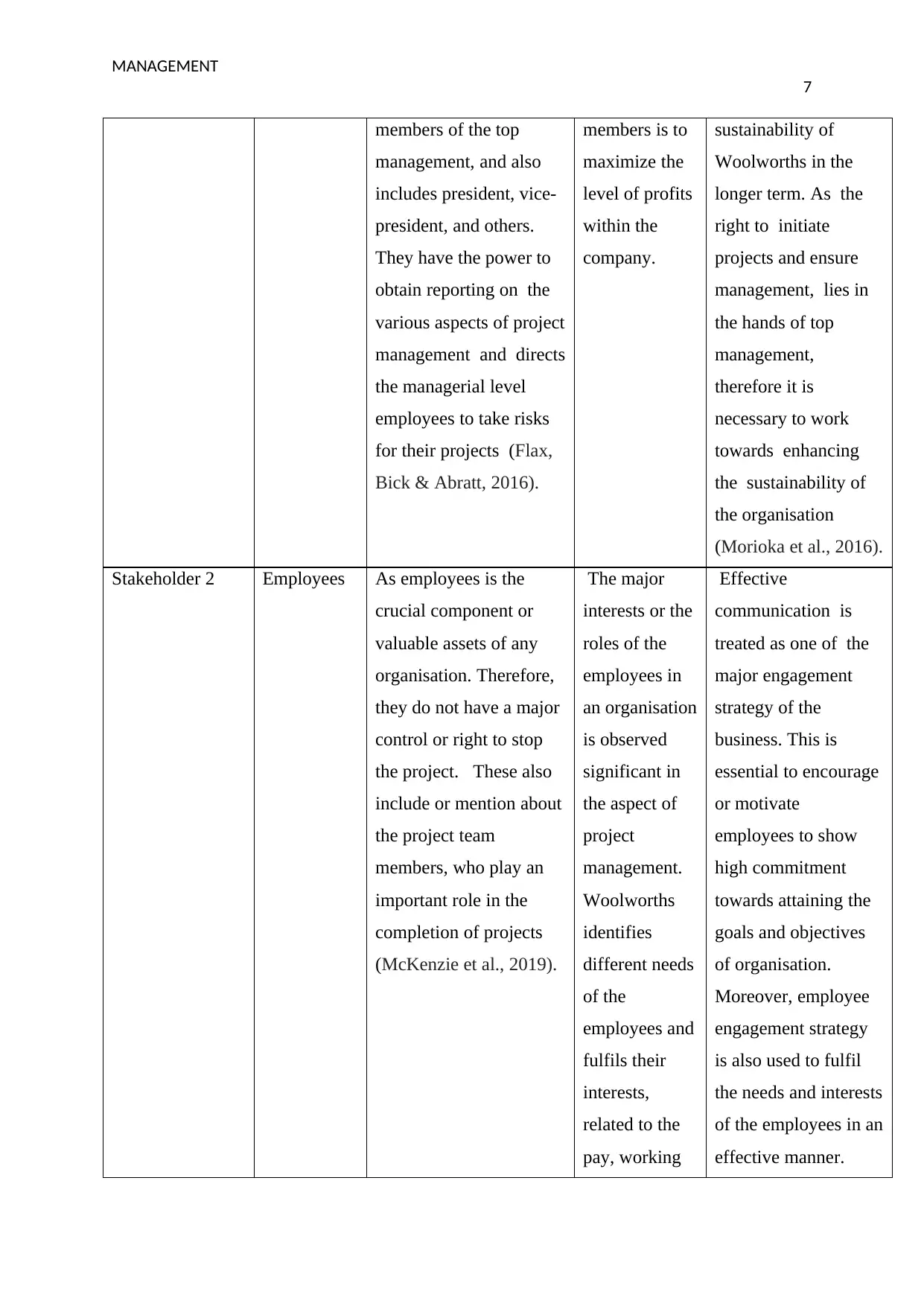
MANAGEMENT
7
members of the top
management, and also
includes president, vice-
president, and others.
They have the power to
obtain reporting on the
various aspects of project
management and directs
the managerial level
employees to take risks
for their projects (Flax,
Bick & Abratt, 2016).
members is to
maximize the
level of profits
within the
company.
sustainability of
Woolworths in the
longer term. As the
right to initiate
projects and ensure
management, lies in
the hands of top
management,
therefore it is
necessary to work
towards enhancing
the sustainability of
the organisation
(Morioka et al., 2016).
Stakeholder 2 Employees As employees is the
crucial component or
valuable assets of any
organisation. Therefore,
they do not have a major
control or right to stop
the project. These also
include or mention about
the project team
members, who play an
important role in the
completion of projects
(McKenzie et al., 2019).
The major
interests or the
roles of the
employees in
an organisation
is observed
significant in
the aspect of
project
management.
Woolworths
identifies
different needs
of the
employees and
fulfils their
interests,
related to the
pay, working
Effective
communication is
treated as one of the
major engagement
strategy of the
business. This is
essential to encourage
or motivate
employees to show
high commitment
towards attaining the
goals and objectives
of organisation.
Moreover, employee
engagement strategy
is also used to fulfil
the needs and interests
of the employees in an
effective manner.
7
members of the top
management, and also
includes president, vice-
president, and others.
They have the power to
obtain reporting on the
various aspects of project
management and directs
the managerial level
employees to take risks
for their projects (Flax,
Bick & Abratt, 2016).
members is to
maximize the
level of profits
within the
company.
sustainability of
Woolworths in the
longer term. As the
right to initiate
projects and ensure
management, lies in
the hands of top
management,
therefore it is
necessary to work
towards enhancing
the sustainability of
the organisation
(Morioka et al., 2016).
Stakeholder 2 Employees As employees is the
crucial component or
valuable assets of any
organisation. Therefore,
they do not have a major
control or right to stop
the project. These also
include or mention about
the project team
members, who play an
important role in the
completion of projects
(McKenzie et al., 2019).
The major
interests or the
roles of the
employees in
an organisation
is observed
significant in
the aspect of
project
management.
Woolworths
identifies
different needs
of the
employees and
fulfils their
interests,
related to the
pay, working
Effective
communication is
treated as one of the
major engagement
strategy of the
business. This is
essential to encourage
or motivate
employees to show
high commitment
towards attaining the
goals and objectives
of organisation.
Moreover, employee
engagement strategy
is also used to fulfil
the needs and interests
of the employees in an
effective manner.
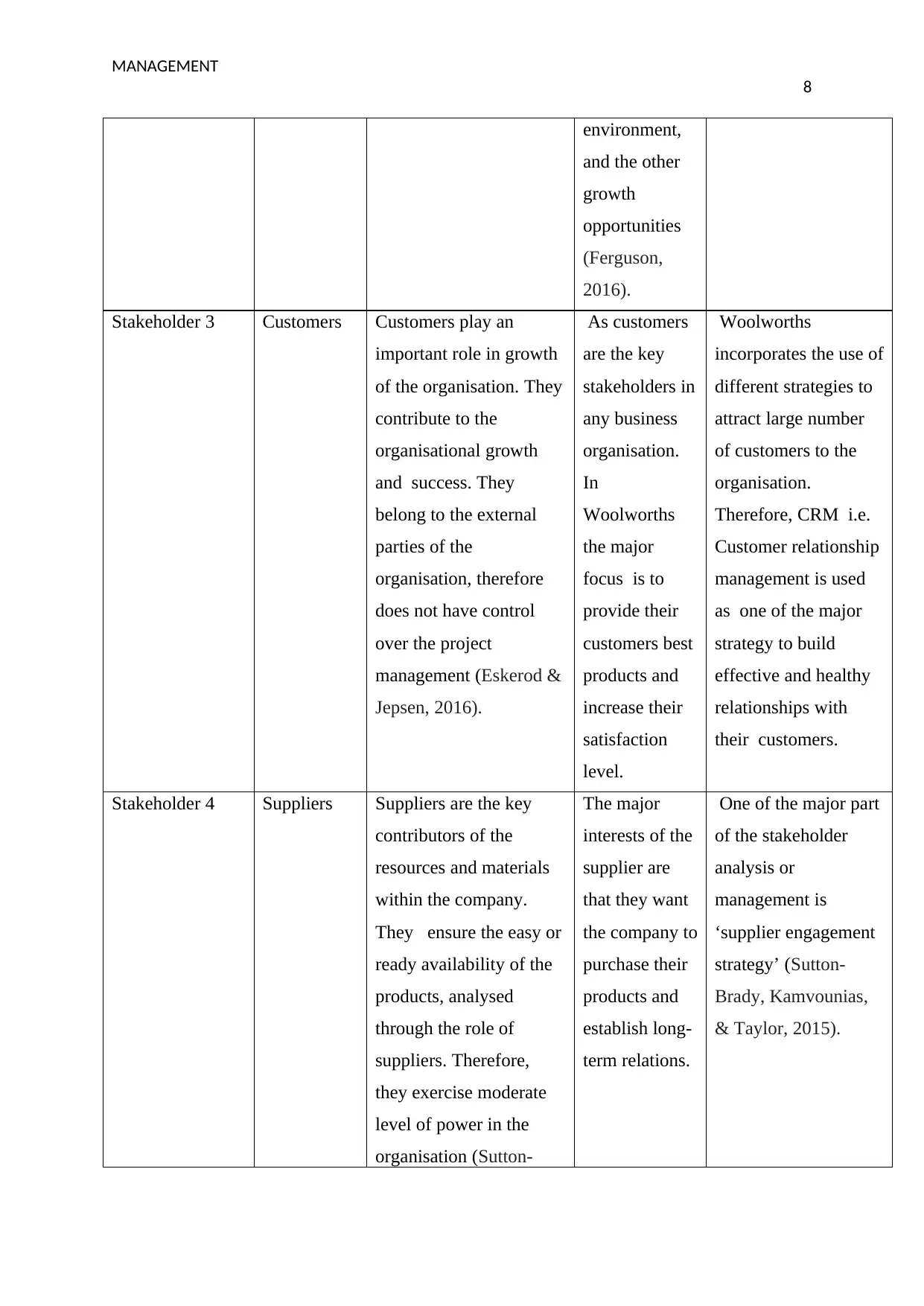
MANAGEMENT
8
environment,
and the other
growth
opportunities
(Ferguson,
2016).
Stakeholder 3 Customers Customers play an
important role in growth
of the organisation. They
contribute to the
organisational growth
and success. They
belong to the external
parties of the
organisation, therefore
does not have control
over the project
management (Eskerod &
Jepsen, 2016).
As customers
are the key
stakeholders in
any business
organisation.
In
Woolworths
the major
focus is to
provide their
customers best
products and
increase their
satisfaction
level.
Woolworths
incorporates the use of
different strategies to
attract large number
of customers to the
organisation.
Therefore, CRM i.e.
Customer relationship
management is used
as one of the major
strategy to build
effective and healthy
relationships with
their customers.
Stakeholder 4 Suppliers Suppliers are the key
contributors of the
resources and materials
within the company.
They ensure the easy or
ready availability of the
products, analysed
through the role of
suppliers. Therefore,
they exercise moderate
level of power in the
organisation (Sutton-
The major
interests of the
supplier are
that they want
the company to
purchase their
products and
establish long-
term relations.
One of the major part
of the stakeholder
analysis or
management is
‘supplier engagement
strategy’ (Sutton-
Brady, Kamvounias,
& Taylor, 2015).
8
environment,
and the other
growth
opportunities
(Ferguson,
2016).
Stakeholder 3 Customers Customers play an
important role in growth
of the organisation. They
contribute to the
organisational growth
and success. They
belong to the external
parties of the
organisation, therefore
does not have control
over the project
management (Eskerod &
Jepsen, 2016).
As customers
are the key
stakeholders in
any business
organisation.
In
Woolworths
the major
focus is to
provide their
customers best
products and
increase their
satisfaction
level.
Woolworths
incorporates the use of
different strategies to
attract large number
of customers to the
organisation.
Therefore, CRM i.e.
Customer relationship
management is used
as one of the major
strategy to build
effective and healthy
relationships with
their customers.
Stakeholder 4 Suppliers Suppliers are the key
contributors of the
resources and materials
within the company.
They ensure the easy or
ready availability of the
products, analysed
through the role of
suppliers. Therefore,
they exercise moderate
level of power in the
organisation (Sutton-
The major
interests of the
supplier are
that they want
the company to
purchase their
products and
establish long-
term relations.
One of the major part
of the stakeholder
analysis or
management is
‘supplier engagement
strategy’ (Sutton-
Brady, Kamvounias,
& Taylor, 2015).
⊘ This is a preview!⊘
Do you want full access?
Subscribe today to unlock all pages.

Trusted by 1+ million students worldwide
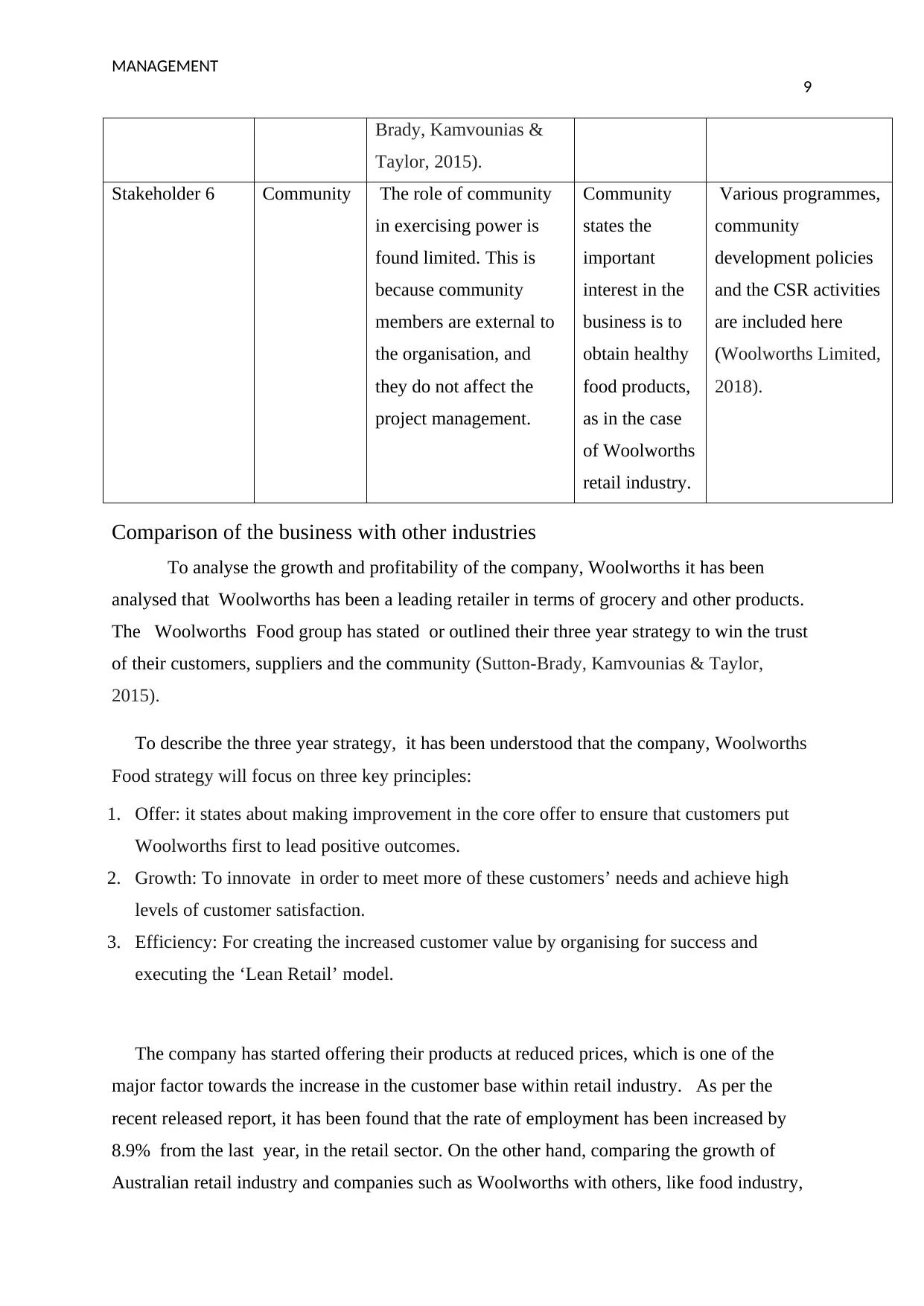
MANAGEMENT
9
Brady, Kamvounias &
Taylor, 2015).
Stakeholder 6 Community The role of community
in exercising power is
found limited. This is
because community
members are external to
the organisation, and
they do not affect the
project management.
Community
states the
important
interest in the
business is to
obtain healthy
food products,
as in the case
of Woolworths
retail industry.
Various programmes,
community
development policies
and the CSR activities
are included here
(Woolworths Limited,
2018).
Comparison of the business with other industries
To analyse the growth and profitability of the company, Woolworths it has been
analysed that Woolworths has been a leading retailer in terms of grocery and other products.
The Woolworths Food group has stated or outlined their three year strategy to win the trust
of their customers, suppliers and the community (Sutton-Brady, Kamvounias & Taylor,
2015).
To describe the three year strategy, it has been understood that the company, Woolworths
Food strategy will focus on three key principles:
1. Offer: it states about making improvement in the core offer to ensure that customers put
Woolworths first to lead positive outcomes.
2. Growth: To innovate in order to meet more of these customers’ needs and achieve high
levels of customer satisfaction.
3. Efficiency: For creating the increased customer value by organising for success and
executing the ‘Lean Retail’ model.
The company has started offering their products at reduced prices, which is one of the
major factor towards the increase in the customer base within retail industry. As per the
recent released report, it has been found that the rate of employment has been increased by
8.9% from the last year, in the retail sector. On the other hand, comparing the growth of
Australian retail industry and companies such as Woolworths with others, like food industry,
9
Brady, Kamvounias &
Taylor, 2015).
Stakeholder 6 Community The role of community
in exercising power is
found limited. This is
because community
members are external to
the organisation, and
they do not affect the
project management.
Community
states the
important
interest in the
business is to
obtain healthy
food products,
as in the case
of Woolworths
retail industry.
Various programmes,
community
development policies
and the CSR activities
are included here
(Woolworths Limited,
2018).
Comparison of the business with other industries
To analyse the growth and profitability of the company, Woolworths it has been
analysed that Woolworths has been a leading retailer in terms of grocery and other products.
The Woolworths Food group has stated or outlined their three year strategy to win the trust
of their customers, suppliers and the community (Sutton-Brady, Kamvounias & Taylor,
2015).
To describe the three year strategy, it has been understood that the company, Woolworths
Food strategy will focus on three key principles:
1. Offer: it states about making improvement in the core offer to ensure that customers put
Woolworths first to lead positive outcomes.
2. Growth: To innovate in order to meet more of these customers’ needs and achieve high
levels of customer satisfaction.
3. Efficiency: For creating the increased customer value by organising for success and
executing the ‘Lean Retail’ model.
The company has started offering their products at reduced prices, which is one of the
major factor towards the increase in the customer base within retail industry. As per the
recent released report, it has been found that the rate of employment has been increased by
8.9% from the last year, in the retail sector. On the other hand, comparing the growth of
Australian retail industry and companies such as Woolworths with others, like food industry,
Paraphrase This Document
Need a fresh take? Get an instant paraphrase of this document with our AI Paraphraser

MANAGEMENT
10
the contribution of retail industry has been found high to the economy of Australia (Spiteri,
Olstad & Woods, 2018).
Moreover, the points of dissimilarities amongst various stakeholders of the businesses in
retail with other industries, such as the composition and the rate of wages or pay to the
employees. Retail industry in Australia provides employment to a wide level, and includes
most of the young population or youngest age profiles under 45 years, or above than 23 years
of age. Moreover, the composition of workforce within retail industries in Australia include
female unlike other industry, which includes more men workers. Hence, it can be stated that
the Australian retail industry is one of the diverse industry and growing significantly with the
support of technology and information (Grimmer, 2018).
Conclusion
To conclude the above discussion it has been analysed that the aspect of stakeholder
management, or stakeholder analysis is vital to the growth and success of the organisation. It
represents as an important technique in the organisations to understand various roles and
responsibilities of the members. The above report has mentioned different stakeholders and
their needs and interests in the organisation, along with their roles. In addition, the aspect of
level of stakeholders influence is also described along with the concept of stakeholder matrix,
within organisation. Woolworths has been found a leading retailer in the organisation
growing towards high growth and sustainability with a strong customer base in future years.
10
the contribution of retail industry has been found high to the economy of Australia (Spiteri,
Olstad & Woods, 2018).
Moreover, the points of dissimilarities amongst various stakeholders of the businesses in
retail with other industries, such as the composition and the rate of wages or pay to the
employees. Retail industry in Australia provides employment to a wide level, and includes
most of the young population or youngest age profiles under 45 years, or above than 23 years
of age. Moreover, the composition of workforce within retail industries in Australia include
female unlike other industry, which includes more men workers. Hence, it can be stated that
the Australian retail industry is one of the diverse industry and growing significantly with the
support of technology and information (Grimmer, 2018).
Conclusion
To conclude the above discussion it has been analysed that the aspect of stakeholder
management, or stakeholder analysis is vital to the growth and success of the organisation. It
represents as an important technique in the organisations to understand various roles and
responsibilities of the members. The above report has mentioned different stakeholders and
their needs and interests in the organisation, along with their roles. In addition, the aspect of
level of stakeholders influence is also described along with the concept of stakeholder matrix,
within organisation. Woolworths has been found a leading retailer in the organisation
growing towards high growth and sustainability with a strong customer base in future years.

MANAGEMENT
11
References
Andriof, J., & Waddock, S. (2017). Unfolding stakeholder engagement. In Unfolding
stakeholder thinking (pp. 19-42). United Kingdom: Routledge.
Bepari, M. K. & Mollik, A. T. (2016). Stakeholders’ interest in sustainability assurance
process: An examination of assurance statements reported by Australian
companies. Managerial Auditing Journal, 31(6/7), 655-687.
Bourne, L. (2016). Stakeholder relationship management: a maturity model for
organisational implementation. United Kingdom: Routledge.
Burns, P. & Dewhurst, J. (Eds.). (2016). Small business and entrepreneurship. United
Kingdom: Macmillan International Higher Education.
Business retail. (2018). Why Woolworths is beating Coles and Aldi in Australia’s on going
supermarket war. Retrieved from:
https://www.news.com.au/finance/business/retail/why-woolworths-is-beating-coles-
and-aldi-in-australias-ongoing-supermarket-war/news-story/
7c0e1ea754035499f71e6364b465345e
Charlesworth, S. & Macdonald, F. (2015). Women, work and industrial relations in Australia
in 2014. Journal of Industrial Relations, 57(3), 366-382.’
Dey, P. K., Bhattacharya, A., Ho, W. & Clegg, B. (2015). Strategic supplier performance
evaluation: A case-based action research of a UK manufacturing
organisation. International Journal of Production Economics, 166, 192-214.
Eskerod, P. & Jepsen, A. L. (2016). Project stakeholder management. United Kingdom:
Routledge.
Ferguson, P. (2016). Productivity growth as a barrier to a sustainability
transition. Environmental Innovation and Societal Transitions, 20, 86-88.
Ferro, C., Padin, C., Svensson, G., Sosa Varela, J. C., Wagner, B. & Høgevold, N. M. (2017).
Validating a framework of stakeholders in connection to business sustainability
efforts in supply chains. Journal of Business & Industrial Marketing, 32(1), 124-137.
11
References
Andriof, J., & Waddock, S. (2017). Unfolding stakeholder engagement. In Unfolding
stakeholder thinking (pp. 19-42). United Kingdom: Routledge.
Bepari, M. K. & Mollik, A. T. (2016). Stakeholders’ interest in sustainability assurance
process: An examination of assurance statements reported by Australian
companies. Managerial Auditing Journal, 31(6/7), 655-687.
Bourne, L. (2016). Stakeholder relationship management: a maturity model for
organisational implementation. United Kingdom: Routledge.
Burns, P. & Dewhurst, J. (Eds.). (2016). Small business and entrepreneurship. United
Kingdom: Macmillan International Higher Education.
Business retail. (2018). Why Woolworths is beating Coles and Aldi in Australia’s on going
supermarket war. Retrieved from:
https://www.news.com.au/finance/business/retail/why-woolworths-is-beating-coles-
and-aldi-in-australias-ongoing-supermarket-war/news-story/
7c0e1ea754035499f71e6364b465345e
Charlesworth, S. & Macdonald, F. (2015). Women, work and industrial relations in Australia
in 2014. Journal of Industrial Relations, 57(3), 366-382.’
Dey, P. K., Bhattacharya, A., Ho, W. & Clegg, B. (2015). Strategic supplier performance
evaluation: A case-based action research of a UK manufacturing
organisation. International Journal of Production Economics, 166, 192-214.
Eskerod, P. & Jepsen, A. L. (2016). Project stakeholder management. United Kingdom:
Routledge.
Ferguson, P. (2016). Productivity growth as a barrier to a sustainability
transition. Environmental Innovation and Societal Transitions, 20, 86-88.
Ferro, C., Padin, C., Svensson, G., Sosa Varela, J. C., Wagner, B. & Høgevold, N. M. (2017).
Validating a framework of stakeholders in connection to business sustainability
efforts in supply chains. Journal of Business & Industrial Marketing, 32(1), 124-137.
⊘ This is a preview!⊘
Do you want full access?
Subscribe today to unlock all pages.

Trusted by 1+ million students worldwide
1 out of 14
Related Documents
Your All-in-One AI-Powered Toolkit for Academic Success.
+13062052269
info@desklib.com
Available 24*7 on WhatsApp / Email
![[object Object]](/_next/static/media/star-bottom.7253800d.svg)
Unlock your academic potential
Copyright © 2020–2025 A2Z Services. All Rights Reserved. Developed and managed by ZUCOL.





